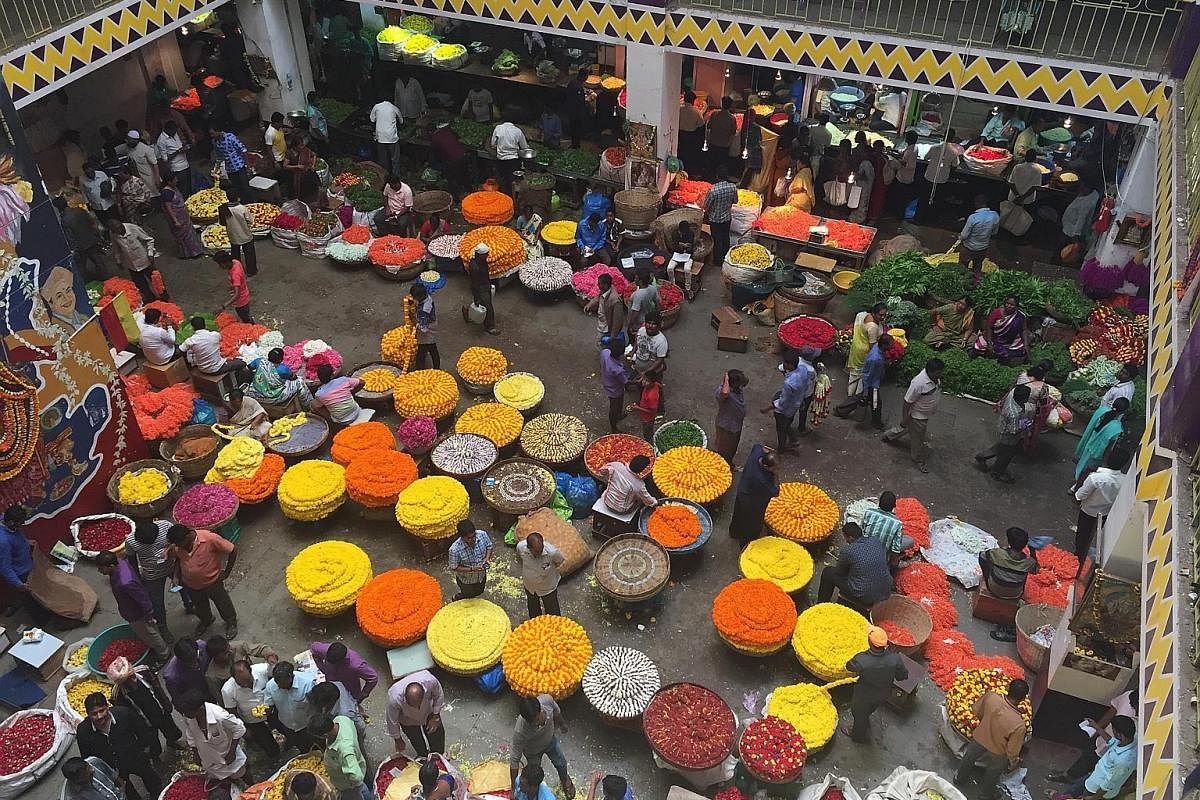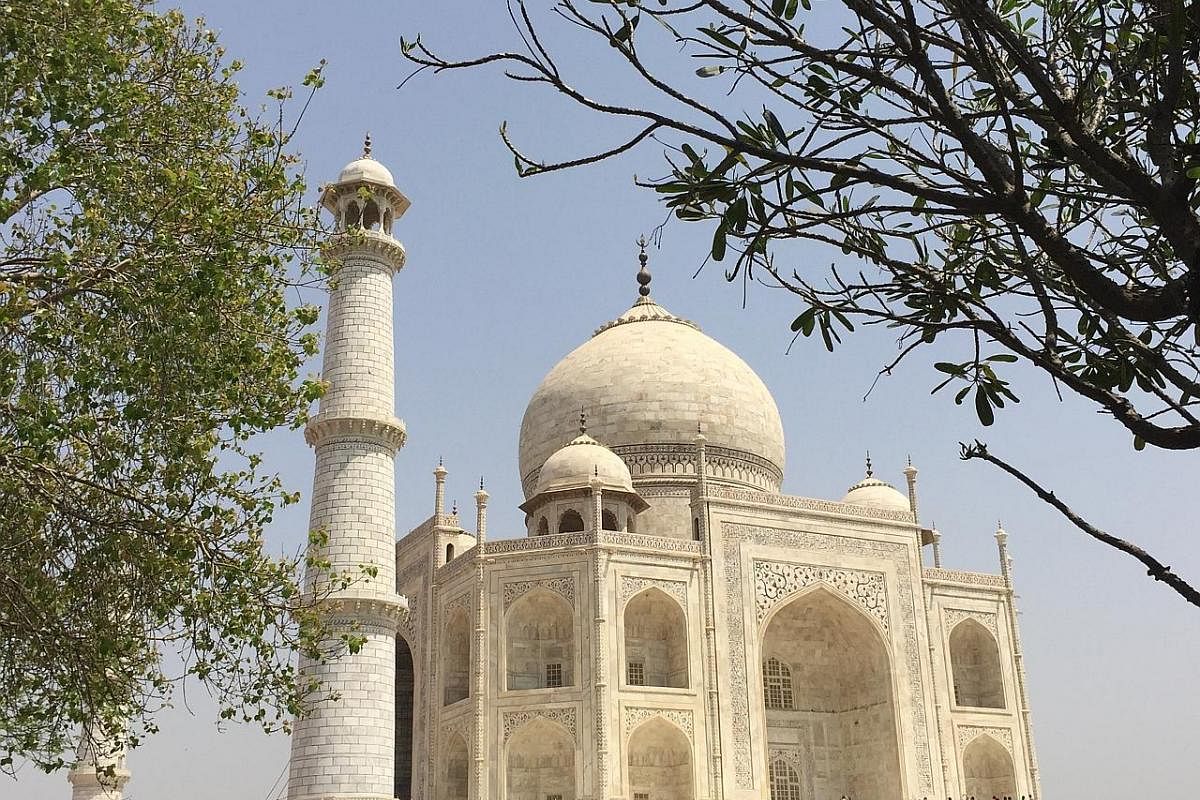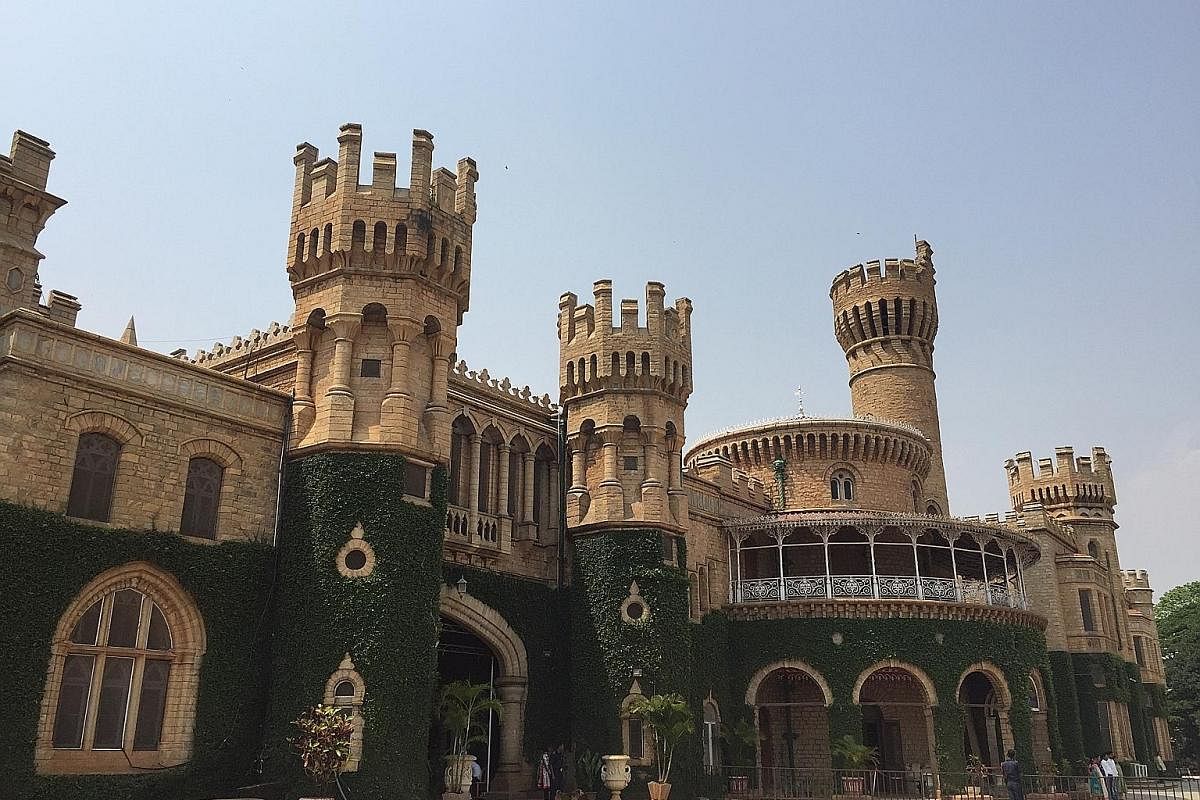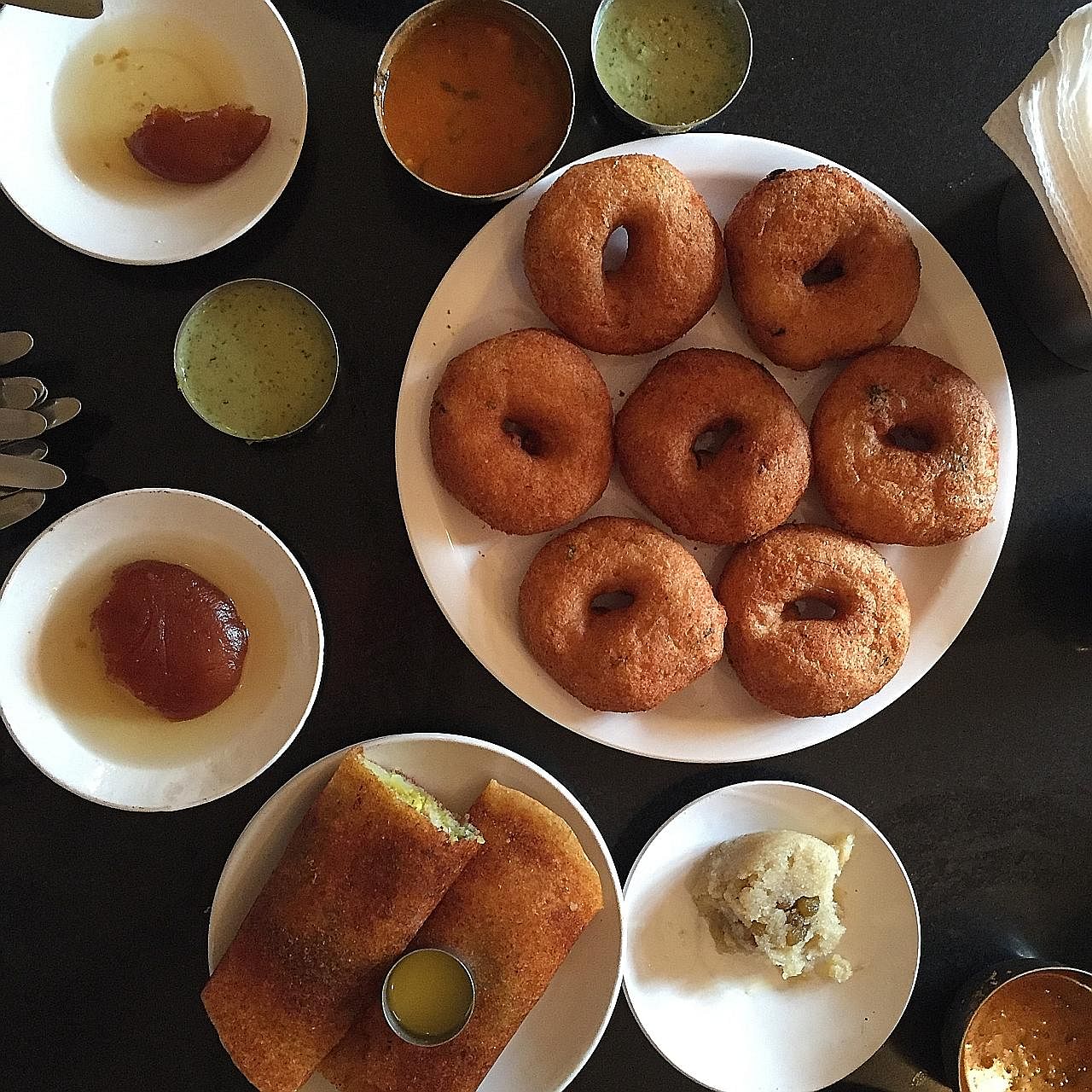-
GETTING THERE
-
For my five-day trip to north and south India, I first fly direct from Singapore to Bangaloreon Jet Airways. I stay at the Leela Palace Bengaluru hotel, where rates start at $235 a night.
Mid-trip, I take a domestic flight on Jet Airways from Bangalore to New Delhi, where I stay at The Leela Palace New Delhi. Room rates begin at $230.
Jet Airways operates daily flights from Singapore to Bangalore and New Delhi.
For more information on the flights and the hotels, go to www.jetairways.com and www.preferredhotels.com.
Tradition and modernity in India
Bangalore and New Delhi are chaotic cities. But they are also filled with beauty, vibrancy and opulence



India has the power to intimidate the traveller, with its overwhelming sights, sounds and sensations, as I discover during a five-day journey to Bangalore in the south and New Delhi in the north.
But alongside the chaos, there is also calm and beauty.
New Delhi captures these contrasts, with its swirling mass of humanity and packed lanes at the Chandni Chowk market. Yet the Taj Mahal beyond the capital is an ideal of love and beauty.
It is the same story of contrasts in Bangalore, where my trip begins.
Military statues, barracks and posters are everywhere because Bangalore used to host the largest British military cantonment in South India.
Their presence will excite history buffs, but it is not a very welcoming first impression.

But soon I spy the Pink Trumpet Trees, which soften the military rigour in a flash, their light-pink flowers calling to mind cherry blossoms.
These blooms are not native to Bangalore, I am told. Their presence, along with global brands such as clothing retailer H&M, show me how the city is changing.
My tour guide the next day is a living representation of these themes of continuity and change.
Ms Aarti Shastry, 25, who works with adventure travel agency Unventured (unventured.com), shows up in a traditional Indian kurta top and leggings. She is quick to tell me she is a modern Indian woman.
"My mother does not approve of what I do," she says of her job, grinning.
She is single, loves scuba diving adventures, plans to cycle across the Himalayas, is passionate about improvisational theatre and drinks a lot of beer.
I imagine her lifestyle when we visit Bangalore-based micro-brewery Toit (toit.in). Located in the vibrant Indiranagar neighbourhood, known for its nightlife, shopping and dining, Toit's drink and food items are described in a cheeky style that appeals to hipsters.
The cocktails, for instance, have names such as Lusty Chocolate and Indian Doctor's Prescription.
In a more traditional mode, we put our fingers to work at Tharangini (www.tharanginistudios.com), a hand block-printing studio nestled in the home of its owner Padmini Govind, 49.
She took over the family business, which was started in 1977, from her mother in 2007.
This hidden gem is home to about 3,000 uniquely hand-cut blocks and no part of the printing process is mechanised.
Hand block-printing is a printing technique and the designs find their way onto everything, from fabric to furniture. While the business still prints traditional motifs such as paisley, peacock feathers and elephants, Ms Govind seeks to keep the technique alive by coming up with contemporary print designs and collaborating with design firms, cafes and home furnishing companies.
Ms Govind says: "We've had to reinvent to stay relevant. We've combined techniques, we're reaching out to schools and businesses, and we're on social media."
Old is gold, though, for other family-run businesses I visit.
Mavalli Tiffin Rooms (www.mavallitiffinrooms.com), one of Bangalore's famous vegetarian restaurants, celebrates traditional, simple fare.
In existence since 1924, the establishment is known for its masala thosai, vadai, and rava idli. These are steamed semolina cakes, which Mavalli Tiffin Rooms claims to have invented during World War II, when rice, usually used for idli, was scarce.
Sarong-clad men serve our piping hot breakfast, including vadai, rava idli and masala thosai, which are served with tiny tubs of ghee.
We eat with our hands in a communal dining room and every dish is flavourful and satisfying.
For locals craving a taste of Bangalore, good news. Mavalli Tiffin Rooms opened its first branch outside India in Singapore's Serangoon Road, in 2013.
Tradition rules too at Chandni Chowk, one of the oldest and busiest markets in Old Delhi.
At Paranthe Wali Gali, a narrow lane dedicated to serving paranthas (Indian flat bread), some stalls claim to have been there for centuries.
A grocery run in these parts of India is not for the faint-hearted or the claustrophobic.
Our local wet markets are nothing compared to the sprawling, chaotic mass that is Chandni Chowk.
I could not be more glad that I was on a guided tour. People, traffic, cows and vehicles surge around the trishaw that is my metal safety net, as the rider and I traverse the market's crowded lanes.
On this harrowing yet must-do ride, I am helpless in a foreign land, feeling both fascinated and overwhelmed .
I feel the same sense of powerlessness in the Krishna Rajendra flower market in Bangalore, which visually captivates with its myriad coloured blooms.
But step into the thick of things and the innocent tourist feels like a pest around the riot of buyers and sellers, who bark instructions and clearly have business to do.
After such excursions in the day, which entail being surrounded by sticky bodies, dust, heat and a cacophony of sounds, our five-star hotels are a respite from the market mayhem.
On this trip, I stay at The Leela Palace hotels in Bengaluru and New Delhi (www.theleela.com). Both are members of Preferred Hotels & Resorts, a company representing more than 650 independent hotels worldwide.
Both hotels offer luxury, serenity and delectable treats for the senses.
At The Leela Palace Bengaluru, the hotel lobby's floral display is made up of 800 roses, niftily tucked into a single vase.
And The Leela Palace New Delhi serves housemade salted butter cumin cookies, light and buttery, which I love.
I am struck by a deep sense of a completely different India in the hotels.
The India that struggles with poverty and filth is also the same India celebrities admire and which wins international accolades.
The Leela Palace Bengaluru's presidential suite has hosted movie star Pierce Brosnan, Russian President Vladimir Putin, and German Chancellor Angela Merkel in recent years.
For more serenity, there is the Taj Mahal, a nearly four-century-old landmark built in 1631 by the Mughal emperor Shah Jahan as a tomb for his favourite wife, Mumtaz Mahal.
While inside the monument of love, our guide flashes a light at a marbled wall inlaid with precious stones such as malachite, turquoise and carnelian.
As the carnelian catches the light, it glows like an ember. Words spring to life as I recall a Bible passage where the walls of the Holy City of God are described as being decorated with a foundation of 12 precious stones, including carnelian.
Many people go to India in search of spirituality.
I did not, but this moment of spiritual enlightenment is soul-stirring. From ivory white beauty to dusty roads, both ends of the spectrum are part of India's allure.
I want to linger on in this colourful country because I know what I have taken in is but the amuse bouche.
I have only nibbled away at the degustation menu that is India.
• The writer was hosted by Preferred Hotels & Resorts, Jet Airways and The Leela Palaces Bengaluru and New Delhi.
Travel tips
• Unless you can spare an entire day wandering and getting lost in Chandni Chowk market in Old Delhi, do not go without a guide. Check if your hotel conducts tours.
• Adventure travel agency Unventured (unventured.com) did a wonderful job of showing us off-the-beaten-track places in Bangalore such as the Mavalli Tiffin Rooms for breakfast and the traditional hand block- printing studio Tharangini. Its guides are articulate and well-informed.
• Bangalore may be the Silicon Valley of India, but it is also home to structures rich in history and architectural beauty. Visit the imposing Bangalore Fort; the Tipu Sultan's Summer Palace where the sultan held court and entertained; and the Tudor-style Bangalore Palace, modelled after the Windsor Castle in England.
• Traffic is unpredictable in both New Delhi and Bangalore, so give yourself ample time to get around, especially to the airport.
• In May this year, temperatures soared to well over 40 deg C in New Delhi. When packing, be sure to include sunscreen, sunglasses and hats.
Join ST's Telegram channel and get the latest breaking news delivered to you.
A version of this article appeared in the print edition of The Sunday Times on July 09, 2017, with the headline Tradition and modernity in India. Subscribe



